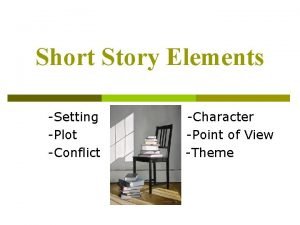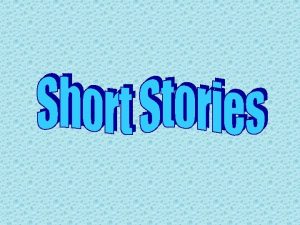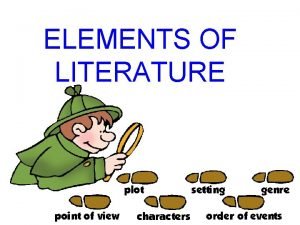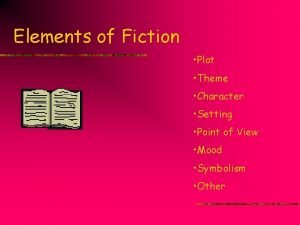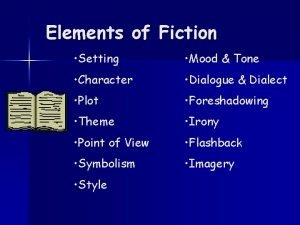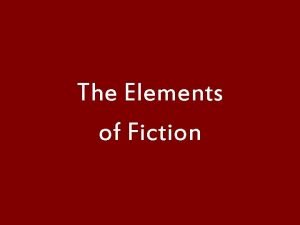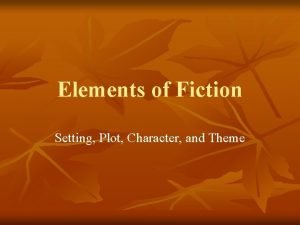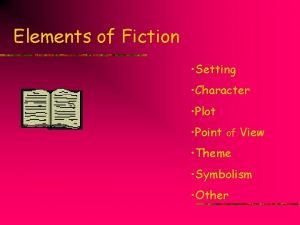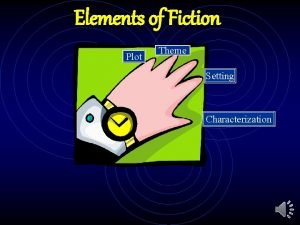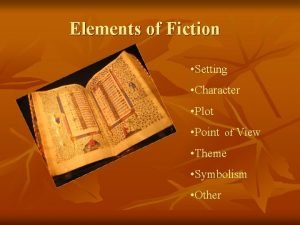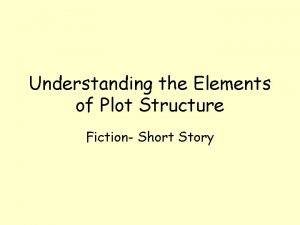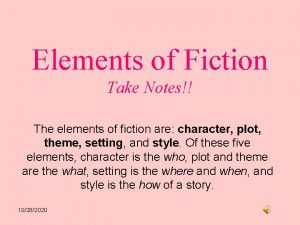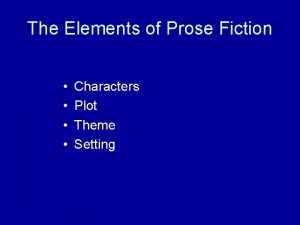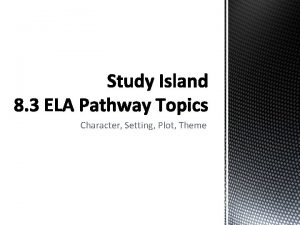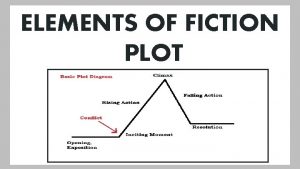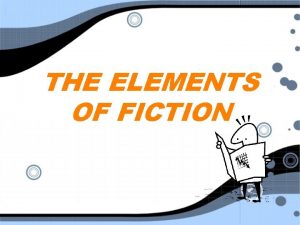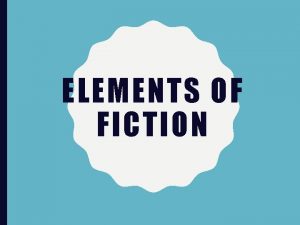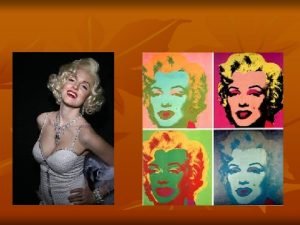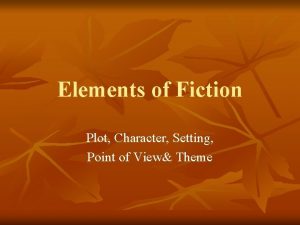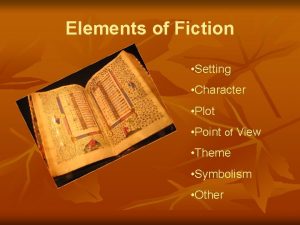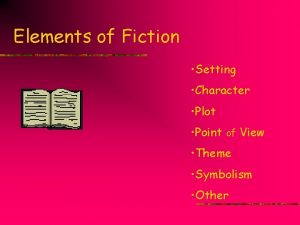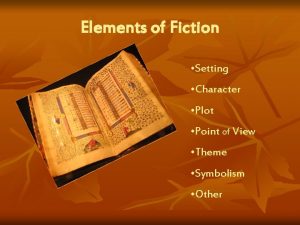Elements of Fiction Setting Plot Character and Theme















- Slides: 15

Elements of Fiction Setting, Plot, Character, and Theme

Fiction: A Genre of Literature n n Works of prose that have imaginary elements Can be inspired by actual events and real people, but springs from writers’ imaginations 2 major types: Novels and Short Stories 4 Basic Elements: Setting, Plot, Character, and Theme

#1 SETTING n n Tells us WHERE and WHEN a story takes place Can reveal about the characters Can provide MOOD or ATMOSPHERE Expresses a TONE (attitude toward a subject or character)

#2 PLOT n n n Sequence of events that make up a story Almost always built around CONFLICTS (problems or struggles) 5 main stages 1. Exposition 2. Rising Actions 3. Climax 4. Falling Actions 5. Resolution

Plot Diagram Turning point in the story; Most tension or suspense; Can be anywhere in the novel Climax Actions following climax; Conflict starts to resolve ll Fa in Development of complications & problems leading to the climax; Suspense builds & plot “thickens” s sin g. A ct on io cti ns g. A Ri Resolution Conflict ↑ & Tension ↑ Exposition Complications Grow Introduction – background info; Sets the stage for the story; Introduces characters, setting, & conflict (Denouement) French: “untying of knots” Conclusion Final outcome of the story

ü for Understanding n FICTION is real or not real. n What is PLOT built around? n Define CONFLICT. n Explain the 5 stages of PLOT: 1) 2) 3) 4) 5) n What is the French term for Resolution?

Conflicts in a Plot n n Conflict – struggle or problem 2 main kinds: External vs. Internal 1) External – a struggle outside of the character; against someone or something else 2) Internal – a struggle within a character’s mind or heart

Types of Conflict n 4 types Self Society Person vs. Nature Person

Sequence & Development of Plot n n Author’s carefully choose the sequence of events and the timeline in which the plot is developed (the order the events are presented) Chronological Order, Reverse Order Flashback START Presents episodes/events From the past Foreshadow TIME LINE Hints or clues of what Is to happen later on Flash-Forward END Jumps ahead to Future events

#3 CHARACTER n Main Characters n n n Protagonist: the main character; often the narrator Antagonist: character that the protagonist struggles against and must overcome Subordinate Characters n Minor characters who add depth and complication

Describing a Character n Round vs. Flat Characters n n n Round: have several sides to their personality; complex, fully developed Flat: have few traits; Undeveloped Dynamic vs. Static Characters n n Dynamic: grow or change by the end of the story; take action, change behavior or attitudes Static: don’t grow or change; stay the same

What is Characterization? n n The way writers create characters in a story 2 ways: n n Direct Characterization – tells us directly what a character is like or what a person’s motives are Indirect Characterization – shows us a character but we have to interpret the character ourselves

What are the methods of INDIRECT Characterization? n Character’s SPEECH n n n 1 st person narration – character speaks directly to the reader Dialogue – what they have to say to themselves and to others Character’s APPEARANCE – look & dress Character’s PRIVATE THOUGHTS Character’s INTERACTIONS – how other characters in the story feel about them or interact with them Character ACTIONS – what they do & how they act

# 4 THEME n n Theme- Is the central message of a story that gives the reader insight about life BIG IDEA + AUTHOR’S BELIEF = STATEMENT OF THEME (1 -2 sentences)

# 5 SYMBOLISM n n A SYMBOL is a thing, person, or idea that represents another larger idea. Authors use symbols to enhance theme or to give readers a greater understanding of a key idea in a story. For example, a dove represents ______.
 Plot character conflict theme setting
Plot character conflict theme setting Short story with characters setting and plot
Short story with characters setting and plot Short story with setting character plot conflict and theme
Short story with setting character plot conflict and theme Elements of fiction theme
Elements of fiction theme What is non foction
What is non foction Tone of a character
Tone of a character Elements of fiction setting
Elements of fiction setting Elements of fiction setting
Elements of fiction setting Elements of fiction setting
Elements of fiction setting Characterization and theme
Characterization and theme Setting elements of fiction
Setting elements of fiction Elements of fiction setting
Elements of fiction setting Elements of fiction plot diagram
Elements of fiction plot diagram Element of fiction theme
Element of fiction theme The elements of prose
The elements of prose Fiction meaning
Fiction meaning
